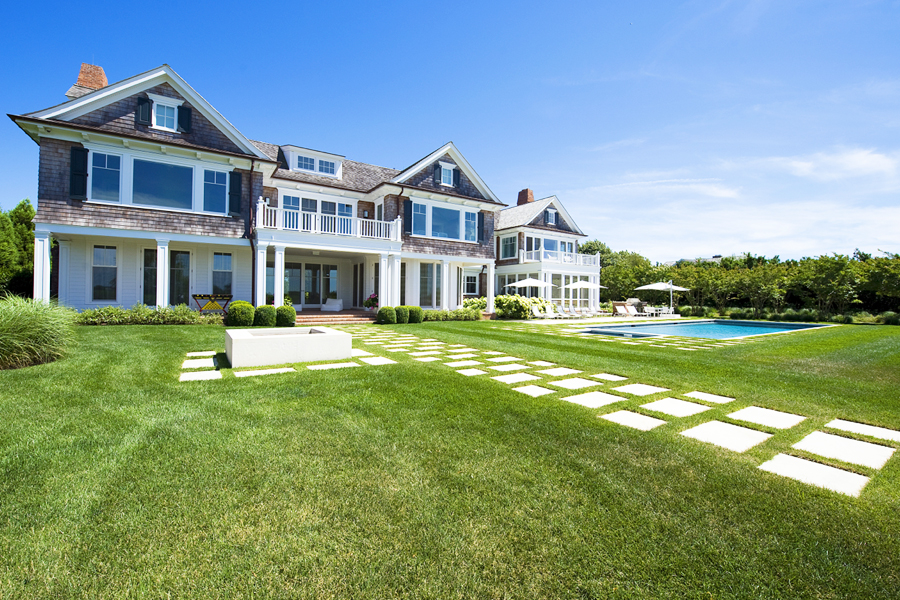Architect Peter Cook Reflects on Innovations and Aspirations That Inspire His Creative Spirit

It’s no surprise that Peter Cook opted to start his namesake architecture firm in the Hamptons—the Cook family has a long history on the South Fork and Peter spent much of his childhood in Bridgehampton. As Cook says, “My extended family has been out in the Hamptons for over 350 years. I count the whole Ludlow family amongst my familial relations. My father’s parents had been coming out here since the ’30s and moved out full-time in the ’50s. They lived on Sagaponack Road. My father was in Bridgehampton immediately following the hurricane in 1938, doing cleanup work. I have been spending time in the Hamptons my entire life.”
Cook moved here full-time in 1982, and today runs one of the area’s most successful full-service architectural firms specializing in custom residential projects. His wealth of experience gives him great insight into life, and real estate, on the East End.

Becoming a part of the East End’s development was an organic process for Cook, as his “grandparents owned the Rev. Brown house on Sagaponack Road, one of the oldest residences in Sagaponack/Bridgehampton. By the time I was coming out here for the summer, they had sold it and were living instead in what used to be a carpenter’s shop right next-door. It was a tiny house that provided many fond memories for me.
“Growing up I had a strong interest in cartooning,” he continues, “and, as one of the six children of a mathematician and an engineer, I had a solid grasp of mathematics and the physical sciences. As I got older I decided to put my artistic and logical brains together and study architecture. I liked the creativeness of architecture and the fact that it was a discipline that had rules and parameters—expressing creativity within the confines of construction and zoning laws, human engineering and safety was a challenge I relished. Architecture presented itself as an option that combined both, art and science. I chose to pursue a professional program in college [at Rensselaer Polytechnic Institute in Troy, NY], and graduated with a degree in building sciences. Following a five-year internship with the prolific, talented and gregarious Bridgehampton architect Eugene L. Futterman, I opened my own practice and first hung the Peter Cook AIA Architect shingle on my door in 1987.”
The architect has gained wide recognition as an expert in his field. He shares that “one of my first professional highlights was being nominated one of the ‘Top 40 architects under 40’ by Progressive Architecture magazine, the bible of architectural magazines in the ’80s and ’90s. Since then my firm has had the honor of being featured in many national publications including among others…Architectural Digest, House and Garden, Home, Dream Homes of New York, Elle Décor and Town
and Country.”
What are the first things you notice when you walk into a home space?
The quality of, or lack of, natural light and the flow and hierarchy of spaces. Does the house feel bright and happy? Do I know where to go? Am I invited by the circulation and the sequencing of spaces into the home? Is the plan choppy or welcoming? I think a well-designed home is positioned to exploit the best qualities of the site. Generously day-lit rooms should be appropriately and cohesively proportioned and movement through the house should be inviting while piquing one’s curiosity.
What are some of your favorite design details?
I think stairways are a critical part of home design and experience. Often a stairway is the most prominent design element in a home. The requirements for building a conforming stair are very strict, so designing a stairway that is at the same time functional, beautiful and an experience for the user is always a challenge. I also enjoy creating multi-function rooms [such as] a bright day-lit family room that, with the push of a button, converts into a dark theater or a screened/covered porch that, with another push of a button, becomes a fully conditioned interior room.
What is one of the most memorable amenities you’ve designed?
Most recently we were asked to include the design of an indoor half-court basketball court in a client’s home that could convert to a garage for winter car storage or open to become an entertaining space for large gatherings. We designed a barn-like wing to the house with electrically operated multi-light barn doors and a full maple gymnasium floor engineered to support the weight of parked cars. When the barn doors are open, the space feels like a roofed open-air pavilion, perfect for a summer party.
Did you design your own homes?
I have renovated my homes, but I have not had an opportunity to do a ground-up construction…yet. It’s something I look forward to in the near future. When I was first married, I had the great fortune of designing and construction managing the renovations and additions to a home that I had seen
from afar my whole life and fantasized about as a child. It was one of the Gardiner family estates. An originally modest Gambrel style home with a shingled, crenelated tower called “Tower Hill” on Brick Kiln Road in North Bridgehampton. As a child I was always curious about “the castle on the hill” when we would pass it on our way to Long Beach—on days when the ocean was too rough for the small children we were—imagine the thrill of not only reconstructing that structure to become a home for my own family, but to also recapture the surrounding properties to restore the grounds to its original grandeur.
As an architect the idea of designing your own environment can be daunting, not only do you have virtually boundless creativity at your disposal and the urge to execute your wildest design ideas, but you need to bear budget in mind. Not many architectural practitioners can afford to build for themselves what they have the privilege of designing and building for their clients! You also have to deal with facing your own work every day—the hits and the misses, the successes and failures of your design. It’s like constantly evaluating yourself in the mirror that’s a lot to contend with!
What is it about Hamptons architecture that you find particularly appealing?
The Hamptons is rich with examples of historic, traditional, transitional, interpretive, contemporary and modern designs all existing, for the most part, harmoniously. For an architect, “Hamptons clients” are not simply people building homes, but they are very often true patrons of the art of architecture.
In the 30 years I have been actively working in the construction/design industry in the Hamptons I’ve seen the “styles” of architecture remain the same yet rotate in popularity. In times of prosperity the modern design style seems to gain popularity, and in times of instability people prefer the comfort of a traditional home. That’s not to say that both styles don’t coexist, and endure together. Quite the contrary. One of the great things about working in the Hamptons is the diversity of architectural styling and clientele.
Right now, I see a shift toward the modern/contemporary home-style, including what I call “transitional” architecture, a blend of the best of modern and traditional. I credit this shift to a few factors. First, technological advancements in construction materials and building envelope elements, which have allowed for greater expanses of glass and open spaces. Second, our lives have become so frenetic and complex, I think the new home dweller appreciates the cleanliness—absence of clutter)—of the modern interior. Here advances in technology and home environmental systems have given the architect greater freedom to design sparse environments that are less dependent on “ornamentation” and more focused on materials, light and space.
What’s an architectural pet peeve of yours?
If I have a pet peeve, it would be the maximum height regulations in our towns. Historically great homes exceeded our current 32- and 35-foot maximums. I think these height limitations, combined with minimum first floor elevations as required by FEMA, have resulted in truncated works of architecture far more offensive than a taller house might have been. My other objection would be abuse of the gambrel roof form. Ill proportioned variations of what used to be an elegant Dutch Colonial roof form has been grossly misused by developers as a way to economically exploit volume and square footage within the maximum height regulations. There seems to be the mistaken belief that “the more Gambrels one puts on a house the better!”
What is an ideal day in the Hamptons for you?
When I am not working, an ideal day in the Hamptons for me will most likely include time on my bicycle, the beach, a boat and dinner with friends at one of our many great local restaurants. And it will always include time with my daughter, Sailor.



See more of Peter Cook’s work at petercookarchitect.com., facebook.com/petercookarchitect, instagram.com/petercookarchitect/, pinterest.com/petercookaia/, twitter.com/petercook_aia.









